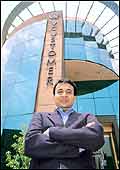 |
| Served in Saravanas: A home-grown chain
with global aspirations, Sarvana Bhavan has 19 outlets in three
Indian cities apart from those in Dubai, Singapore, Ontario
and Mountain View in California |
|
|
| Made in McDonald's: The Golden Arches
area global phenomenon. With revenues of $15.5 billion (Rs 71,300
crore), the multinational corporation has 30,000 outlets in
119 countries |
The
Nadars, a Tamil community traditionally into the grocery and retail
business, are a pious people. It's a popular belief among them that
ventures bearing the name Saravana (a Hindu God) rarely fail. Ergo,
when Nadar P. Rajagopal started his restaurant business in Chennai
in 1981, it was only in the fitness of things that he name it Saravana
Bhavan and decorate the restaurant, and all that came after it,
in Delhi or Dubai, with pictures of Gods and Godmen.
A few metres away from the only Saravana Bhavan
in Delhi (on heaving Janpath, if you must know), is one of the 22
Delhi outlets of McDonald's. Here, it is the more secular figure
of Ronald McDonald that holds centre stage.
That Saravanas (as the chain is known) and
McDonald's would meet each other in a bustling borough was preordained.
The first is a home-grown chain with 19 outlets across three Indian
cities, a presence in Dubai, Singapore, Ontario and Mountain View
in California, estimated revenues of Rs 300 crore, and global aspirations.
The other is a $15.5 billion (Rs 71,300 crore) multinational corporation
with 30,000 outlets in 119 countries.
Still, this isn't a how-the-dosa-held-its-own-against-the-burger
kind of story. There's nothing much that separates the two Janpath
outlets: apart from the numerical similarity (See The Numbers Game),
a McChicken Burger and a Saravanas masala dosa taste the same anywhere
in world.
At the core of any successful fast food operation
are efficient processes and a superlative supply chain. That's true
of the two chains discussed here. A McDonald's kitchen takes up
very little space. And virtually no cooking happens in it. The most
important ingredient of a chicken burger is the patty. Readymade
and frozen, this is heated precisely for two minutes on a hotplate
whose temperature is electronically controlled. Then come the sauces
and the vegetables, and the burger travels down to the delivery
counter with a tag indicating its time of production. If it doesn't
fly off the shelf in the stipulated 10 minutes, it goes into the
waste bin. "It's not so much about the quick service or the
ambience. What matters is that we serve the food hot and fresh,"
says Vikram Bakshi, MD, McDonald's India (North).
Saravanas' kitchen is all shiny stainless steel,
but it is thrice as big as the McDonald's one. The shelf life for
chutneys is 30 minutes; for sambhar, four hours. Absent are the
timer clocks and electronic temperature controls. This is still
the domain of hand-measures and good ol' intuition. Technology manifests
itself in the form of roving ceiling-mounted cameras. The images
can be seen live by Saravanas' top bosses in Chennai.
If standardisation helps McDonald's ensure
a burger tastes the same across geographies, then training does
the same thing for Saravanas' dosas. Its cooks undergo a six-month
long training course at an in-house school in Chennai.
The McDonald's supply chain is an international
benchmark. In India, the company has developed 50 vendors from whom
it sources almost all its requirements (frozen fries are imported
from Holland because Indian potatoes have a high sugar content;
palm oil from Malaysia). And to cater to the 30 McDonald's outlets
in the north, the company has a distribution and cold storage centre
in Noida, 30 kilometres from Delhi. Here, two huge storages are
maintained at minus 22 degrees Celsius (a temperature at which milk,
lettuce, chicken patties, and fish can stay fresh a few months).
A battery of five refrigerated trucks makes two-to-three trips every
week to each restaurant to replenish stocks.
| THE NUMBERS GAME |
Average bill size:
McDonald's: Rs 100
Saravana Bhavan: Rs 70
Footfalls/day:
McDonald's: 1,200 and 1,500 (weekends)
Saravana Bhavan: 1,500 and 2,000
(weekends)
Food:
McDonald's: Approximate number
of burgers
(all varieties) served in a day: 400-500
Saravana Bhavan: Number of dosas
served (all varieties): 900
|
The whole network is so efficient that McDonald's
Bakshi is inundated with requests from manufacturing companies that
want to emulate the fast food major's supply chain.
Saravana Bhavan boasts no mega cold storages,
no refrigerated trucks. Its vendors (the company is secretive about
their identities) are all based in Tamil Nadu. HQ sources supplies
and ships them to all branches, even the ones overseas. "There
are some vegetables, spices, coconuts and certain varieties of rice
that you get only in the southern states," explains S. Mahalingam,
Branch Manager at Delhi's Saravana Bhavan.
For instance, the Janpath outlet's supply of
2,500 coconuts, an equal number of plantain leaves, 500 kilogrammes
of rice and lentils and hundreds of kilogrammes of vegetables arrives
in Delhi twice a week, in the Tamil Nadu or The Grand Trunk Express
after a journey of between 32 and 36 hours. It works for them. And
it's as Indian as, well, a dosa.
Gone Flat
Or how Coke and Pepsi tripped after a great
start.
 |
| One for the road: Angry protestors empty
out Coke and Pepsi bottles |
The press conference
was called hurriedly. It was august 5. At noon, Delhi-based non-governmental
organisation Centre for Science and Environment (CSE) had brought
out a report alleging that several Coca-Cola and PepsiCo brands
contained high levels of pesticides. At 5.00 p.m., PepsiCo India's
CEO Rajeev Bakshi, and Coca-Cola India's President Sanjiv Gupta
addressed a joint press conference. "If the allegations turn
out to have the potential to tarnish our image, we will consider
all options, even legal," said Gupta. Bakshi, too, was combative.
"(The report) is completely baseless," he said.
The conference was a good idea. Then, the two
cola majors went all over the place. One's CEO hinted darkly that
CSE's report would hurt foreign direct investment into India. The
other questioned CSE's credentials. All the while, sales of both
companies continued to plummet, by as much as 30-40 per cent in
some cases. Finally, Pepsi approached the Delhi High Court which
directed the government to revert with an independent test. The
Supreme Court threw out a similar plea from Coke.
Still, the two companies may well have fallen
into the regulation trap. The health minister may have assured parliament
that Pepsi and Coke products conform to Indian standards, but she
did assert that India would soon move to the more stringent EU standards.
And calls for a proble by a Joint Parliamentary Committee haven't
entirely ceased. Worse, the two companies have done little to bridge
the yawning disconnect that has opened up between their brands and
consumers. "We understand that rational methods have to be
extraneous to the company," says Bakshi, defending Pepsi's
decision to go to the courts. We'll soon know whether the "rational
methods" worked.
-Shailesh Dobhal
Are IP-Based
Call Centres More Efficient?
The short answer to that is y-e-s.
 |
| Sanjay Kumar, CEO, vCustomer: IP is it |
Quick, what do
call centres do when they want to cut costs by a third? They migrate
to an IP (Internet Protocol) infrastructure. For those who came
in late, IP is all about piping data (and voice) through networks
in packets, a technology that is far more efficient than the traditional
circuit-switching one where a dedicated circuit is established between
the source and the destination of the data. "Using compression
technologies, IP permits more voice channels per leased line,"
says Amit Mehta, National Marketing Manager for contact centre solutions
at Tata Telecom.
Add sweeteners such as rapid start-up (two
weeks as against months) and it is easy to see why IP is all the
rage.
Delhi-based call centre vCustomer's 2,000 agents
handle over two million calls a month on an IP infrastructure.
And start-ups like Bangalore-based Nirvana
are counting on the IP advantage to create a differential. IP, IP,
...
-Vandana Gombar
Accountable
Governments
Local governments are discovering the pleasure
and the pain of going double-entry.
 In
the next few months the municipal corporation of Delhi proposes
to raise some Rs 250 crore from the bond market. The corporation
has its new accrual-based double-entry system of financial accounting
to thank for that. It was while moving away from its old cash-based
single-entry accounting system to the newer, more-efficient one
that the MCD realised that it had assets worth Rs 4,600 crore. "Now,
we can use these assets to raise funds," says Pravin Tripathi,
mcd's chief accountant. In
the next few months the municipal corporation of Delhi proposes
to raise some Rs 250 crore from the bond market. The corporation
has its new accrual-based double-entry system of financial accounting
to thank for that. It was while moving away from its old cash-based
single-entry accounting system to the newer, more-efficient one
that the MCD realised that it had assets worth Rs 4,600 crore. "Now,
we can use these assets to raise funds," says Pravin Tripathi,
mcd's chief accountant.
The genesis of MCD's desire to go the double-entry
way lies in a December 2001 judgement delivered by the Supreme Court
in response to a 1996 public interest litigation (PIL). The court
asked MCD to "maintain accounts as per the mercantile system
of accounting". Bangalore's city corporation has already moved
to such a system, Tamil Nadu has begun the conversion work for its
local bodies, and Haryana and Chattisgarh soon will.
But why should corporations shift to an accrual
system of accounts? "The new system shows where the corporation
gets its resources and what it uses them for and whether it is in
a position to cover its costs," says B. Chakravarty, the man
MCD has put in charge of its switchover. That's pretty much what
Management Accounting 101 says an accounting system should do.
Making the change isn't as easy as it looks,
warns Ramesh Ramanathan, a member of the Bangalore Agenda Task Force
who helped the city corporation move to a fund-based accounting
system. "The devil is in the details because it isn't just
about a different accounting system, but an entire business process
re-engineering exercise." One level of detailing involves treating
different types of assets-such as a shopping mall owned by the corporation
that it can let out and a park owned by it that it has to maintain-differently.
Another deals with using the output of the system to gain the trust
of citizens. "A 1,000 such issues need to be addressed before
the benefits of a new accounting system accrue to the common man,"
says Ramanathan. Still, it's a start.
-Ashish Gupta
|
